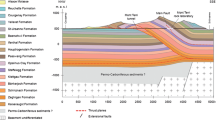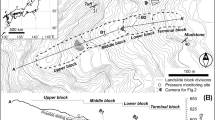Abstract
This paper analyzes the effects of a historical rain series on pore water pressure distribution in the Costa della Gaveta landslide, in the Southern Apennine, Italy. The effects of pore water pressure variations on the safety factor and on the displacement rate of the landslide are also analysed. The aim of the investigation is to reach a deeper understanding of the influence of hydrological parameters on the mechanism of movements of the widespread type of active, very slow landslides in fine-grained soils. Pore water pressures were evaluated by means of the 3D finite difference code MODFLOW, applying as boundary condition the long historical rainfall series of the site. The transient analysis carried out with a daily resolution successfully reproduces the trend of piezometric data. The results show that because of the subsoil low permeability (k = 10−8–10−9 m/s), pore water pressure variations caused by rain are significant only at depths lower than about 10 m. Furthermore, noticeable depth-depending time lag is evaluated between the external hydrological input and responses of internal pore water pressures. Pore water pressure variations on the shallowest areas of the slip surface have the greatest influence on the 3D limit equilibrium safety factor and thus on the landslide movements. As a matter of fact, the safety factor seems to be well correlated to the displacement rates evaluated by inclinometers at various depths, on the slip surface. The results of the 3D model provide pore water pressure distributions which are significantly different, both in value and in time trend, from those obtained by using 2D models.




















Similar content being viewed by others
References
Alonso EE, Gens A, Delahaye CH (2003) Influence of rainfall on the deformation and stability of a slope in overconsolidated clays: a case study. Hydrogeol J 11:174–192
Angeli MG, Gasparetto P, Menotti RM, Pasuto A, Silvano S (1996) A visco-plastic model for slope analysis applied to a mudslide in Cortina d’Ampezzo, Italy. Q J Eng Geol 29:233–240
Angeli MG, Buma J, Gasparetto P, Pasuto A (1998) A combined hillslope hydrology/stability model for low gradient clay slopes in the Italian dolomites. Eng Geol 49:1–13
Bogaard TA, Van Asch TWJ (2002) The role of the soil moisture balance in the unsaturated zone on movement and stability of the Beline landslide, France. Earth Surf Process Landf 27:1177–1188
Boukhemacha MA, Radu GC, Bica I (2013) Numerical study on temporal domain discretizing for hydrogeological modeling practices. Math Model Civ Eng 9(1):1–15
Calcaterra S, Cesi C, Di Maio C, Gambino P, Merli K, Vallario M, Vassallo R (2012) Surface displacements of two landslides evaluated by GPS and inclinometer systems: a case study in Southern Apennines, Italy. Nat Hazards 61:257–266
Calvello M, Cascini L, Sorbino G (2007) A numerical procedure for predicting rainfall-induced movements of active landslides along pre-existing slip surfaces. Int J Numer Anal Methods Geomech 32(4):327–351
Cascini L, Versace P (1986) Eventi pluviometrici e movimenti franosi. Proceedings XVI Italian Geotechnical Conference, 14–16 May, Bologna, Italy, Vol. 3, 171–184
Cascini L, Calvello M, Grimaldi GM (2010) Groundwater modelling for the analysis of active slow-moving landslides. J Geotech Geoenviron Eng (ASCE) 136(9):1220–1230
Chen Z, Mi H, Zhang F, Wang X (2003) A simplified method for 3D slope stability analysis. Can Geotech J 40:675–683
Comegna L, Picarelli L, Bucchignani E, Mercogliano P (2013) Potential effects of incoming climate changes on the behaviour of slow active landslides in clay. Landslides 10:373–391
Commend S, Geiser F, Tacher L (2004) 3D numerical modeling of a landslide in Switzerland. Proceedings of the International Symposium on Numerical Models in Geomechanics NUMOG IX, Ottawa, pp 595–601
Corominas J, Moya J, Ledesma A, Lloret A, Gili JA (2005) Prediction of ground displacements and velocities from groundwater level changes at the Vallcebre landslide (Eastern Pyrenees, Spain). Landslides 2:83–96
Cruden DM, Varnes DJ (1996) Landslide types and processes. In: Landslide: investigation and mitigation. Special Report 247. Transportation Research Board, Washington, 36–75
Di Maio C, Vassallo R, Vallario M, Pascale S, Sdao F (2010) Structure and kinematics of a landslide in a complex clayey formation of the Italian Southern Apennines. Eng Geol 116:311–322
Di Maio C, Vassallo R, Vallario M (2013) Plastic and viscous shear displacements of a deep and very slow landslide in stiff clay formation. Eng Geol 162:53–66
Di Maio C, Scaringi G, Vassallo R (2014) Influence of pore fluid composition on the residual strength of a clayey landslide. In: Lollino G et al. (eds) Engineering Geology for Society and Territory. Proceedings of IAEG 2014 Congress, 15–19 September 2014. volume 2, Springer, Turin, Italy, p 6
François B, Tacher L, Bonnard C, Laloui L, Triguero V (2007) Numerical modelling of the hydrogeological and geomechanical behaviour of a large slope movement: the Triesenberg landslide (Liechtenstein). Can Geotech J 44:840–857
Harbaugh AW (2005) MODFLOW-2005, The U.S. Geological Survey modular ground-water model—the ground-water flow process: U.S. Geological Survey techniques and methods, 6-A16
Hong Y, Hiura H, Shino K, Sassa K, Fukuoka H (2005) Quantitative assessment on the influence of heavy rainfall on the crystalline schist landslide by monitoring system-case study on Zentoku landslide, Japan. Landslides 2:31–41
Jiao J.J., Nandy S., Malone, A., 1999. Hydrological studies of the slope failure at Tuen Mun Highway Chainage 550, Hong Kong. Proc. 2nd International Conference on Landslides, Slope Stability, and the Safety of Infra-Structures, 27–28 July 1999, CI-Premier Conference Organisation, Singapore, 177–184
Krahn J (2004) Vadose zone modeling with VADOSE/W—an engineering methodology. GEO-SLOPE International Ltd., Calgary
Laloui L, Ferrari A, Bonnard C (2009) Geomechanical modeling of the Steinernase landslide (Switzerland). In Proceedings of the 1st Italian Workshop on Landslides, June 8–10, Naples, Italy, 186–195
Ledesma A, Corominas J, González DA, Ferrari A (2009) Modelling slow moving landslides controlled by rainfall. In Proceedings of the 1st Italian Workshop on Landslides, June 8–10, Naples, Italy, 196–205
Leroueil S (2001) Natural slopes and cuts: movement and failure mechanisms. Geotechnique 51(3):197–243
Leroueil S, Locat J, Vaunat J, Picarelli L, Lee H, Faure R (1996) Geotechnical characterization of slope movements. Proceedings of the VII international Symposium on Landslides, Trondheim, 1, 53–74
Mandolini A, Urciuoli G (1999) Previsione dell’evoluzione cinematica dei pendii mediante un procedimento di simulazione statistica. Riv Ital di Geotecnica 35–42
Manfreda S, Di Santo G, Iacobellis V, Fiorentino M (2002) A regional analysis of rainfall pattern in Southern Italy. Proceedings of the 4rd EGS Plinius Conference, Mallorca, Spain, October 2002, 4 pp., on CD-rom
Maugeri M, Motta E, Raciti E (2006) Mathematical modelling of the landslide occurred at Gagliano Castelfranco (Italy). Nat Hazards Earth Syst Sci 6:133–143
Pescatore T, Renda P, Tramutoli M (1988) Rapporti tra le unità lagonegresi e le unità sicilidi nella media valle del Basento, Lucania (Appennino Meridionale). Mem Soc Geol Ital 41:353–361
Pescatore T, Renda P, Schiattarella M, Tramutoli M (1999) Stratigraphic and structural relationships between Meso-cenozoic Lagonegro basin and coeval carbonate platforms in southern Italy. Tectonophysics 315:286–295
Picarelli L, Urciuoli G, Russo C (2004) Effects of groundwater regime on the behavior of clayey slopes. Can Geotech J 41(3):467–484
Shrestha HK, Yatabe R, Bhandary NP (2008) Groundwater flow modeling for effective implementation of landslide stability enhancement measures. A case of landslide in Shikoku, Japan. Landslides 5:281–290
Spencer E (1967) A method of analysis of stability of embankments assuming parallel inter-slice forces. Geotechnique 171:11–26
Tacher L, Bonnard CH, Laloui L, Le Parriaux A (2005) Modelling the behaviour of a large landslide with respect to hydrogeological and geomechanical parameter heterogeneity. Landslides 2:3–14
Thornthwaite CW (1948) An approach toward a rational classification of climate. Geogr Rev 38(1):55–94
Tommasi P, Ribacchi R, Sciotti M (1997) Slow Movements along the slip surface of the 1900 Porta Cassia landslide in the clayey slope of the Orvieto Hill. Riv Italiana di Geotecnica 2:49–58
Vallario M (2012) Kinematics of two landslides in Varicoloured Clays and analysis of possible triggering factors. Ph.D. Thesis, University of Basilicata, Potenza, Italy (in Italian)
Van Asch TWJ, Hendriks MR, Hessel R, Rappang FE (1997) Hydrological triggering conditions of landslides in varved clays in the French Alps. Eng Geol 14:239–251
Van Asch THWJ, Van Beek LPH, Bogaard TA (2007) Problems in predicting the mobility of slow-moving landslides. Eng Geol 91:46–55
Vassallo R, Pagliuca R, Di Maio C (2013) Monitoring of the movements of a deep, slow, clayey landslide and 3D interpretation. Italian J Eng Geol Environ Book Ser 6:359–367
Vaunat J, Leroueil S, Faure RM (1994) Slope movements: a geotechnical perspective. Proc. 7th International Congress of the International Association of Engineering Geology, Lisboa, 1637–1646
Vulliet L, Hutter K (1988) Viscous-type sliding laws for landslides. Can Geotech J 25(3):467–477
Acknowledgments
The authors would like to thank Prof. S. Di Nocera for giving useful suggestions on the interpretation of geological data. Special thanks are due to Mr. M. Belvedere for carrying out in situ measurements. Part of this research has been funded by the Italian Ministry of Instruction, University and Research (PRIN project 2010–2011: landslide risk mitigation through sustainable countermeasures).
Author information
Authors and Affiliations
Corresponding author
Rights and permissions
About this article
Cite this article
Vassallo, R., Grimaldi, G.M. & Di Maio, C. Pore water pressures induced by historical rain series in a clayey landslide: 3D modeling. Landslides 12, 731–744 (2015). https://doi.org/10.1007/s10346-014-0508-7
Received:
Accepted:
Published:
Issue Date:
DOI: https://doi.org/10.1007/s10346-014-0508-7




